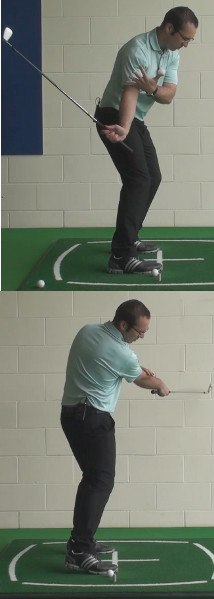2 of 5 | < Previous Next >
- Lazy lower body. The lower body plays a powerful role in the golf swing – more than most players realize. If your lower body isn’t doing its job during the downswing, the club face will likely rotate too quickly and end up in a closed position. The rotation of your body in the downswing not only serves to build power, but also to control the position of the club face and keep it square with the target line. As soon as your lower body stops turning toward the target, the club face will quickly ‘flip over’ and wind up pointing well to the left. The first thing you should do when you realize that you are dealing with a pull is make sure that your lower body is doing its job correctly.
- Short backswing. A good backswing is important for a number of reasons, but proper timing is the most notable. Making a full backswing that includes a good tempo is key because it will help you maintain a square clubface position. If you were to cut the backswing short for some reason, your body won’t have time to rotate through the hitting zone and the shot is likely to be pulled. Often, this mistake is seen when a golfer gets nervous – they want to get through the swing as quick as possible because they are anxious about the shot, so they cut the backswing shot and the ball is pulled to the left. Focus on completing your backswing on every swing, even if you are feeling a little nervous at the time.
- Strong grip. The golf grip is a personal thing that will vary greatly from one player to the next. However, if you use a particularly strong grip to hold the club, you will always be in danger of hitting a pull. A strong grip makes it easier for your hands to rotate the club through impact, meaning it will take less effort for you to hit a pull than it will for someone with a weaker grip. Should you decide to use a strong grip in your game, it will be even more important that your lower body is able to do its job and rotate aggressively toward the target during the downswing. Without that rotation, a pulled golf shot is almost sure to result.

To properly solve any problem, you need to first understand it thoroughly. This is definitely the case with a pulled golf shot – to understand how to stop pulling golf shots, you need to understand the root cause of the issue.
Once you know what causes a pulled golf shot, you will be a big step closer to making the necessary corrections and getting your ball back on track. Pulling golf ball left is no fun, but it is a swing fault that you can fix with some practice and attention to detail.
At the most basic level, a pulled golf shot occurs because the club face is pointed to the left of your target at impact. Even if you do everything else perfectly throughout your swing, having the club face pointed left of the target at impact is going to result in a pulled shot. It really is as simple as that. Of course, figuring out why the club face is pointed to the left of the target in the first place will be a little more complicated.
While there could be endless possible explanations for reaching an impact position that has the club face pointed too far to the left, the three causes below are by far the most common.
Playing a round of golf pulling shots is no fun – you are always fighting to keep the ball on line. If you are currently fighting a pull in your own game, start by thinking about the three causes above and determine if any of those are present in your swing. To get serious about fixing this problem once and for all, spend some time on the practice range to work out any issues you have that may be causing the pull before heading back out onto the course.





